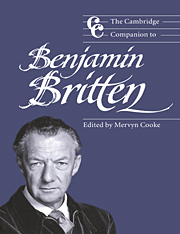Book contents
- Frontmatter
- Introduction
- Part one Apprenticeship
- Part three Perspectives
- 9 Distant horizons: from Pagodaland to the Church Parables
- 10 Violent climates
- 11 Britten as symphonist
- 12 The concertos and early orchestral scores: aspects of style and aesthetic
- 13 The chamber music
- 14 Music for voices
- Part four The composer in the community
- Notes
- Index of Britten's works
- General index
14 - Music for voices
from Part three - Perspectives
Published online by Cambridge University Press: 28 September 2011
- Frontmatter
- Introduction
- Part one Apprenticeship
- Part three Perspectives
- 9 Distant horizons: from Pagodaland to the Church Parables
- 10 Violent climates
- 11 Britten as symphonist
- 12 The concertos and early orchestral scores: aspects of style and aesthetic
- 13 The chamber music
- 14 Music for voices
- Part four The composer in the community
- Notes
- Index of Britten's works
- General index
Summary
From his early boyhood, Britten seems to have been fascinated by the musical possibilities inherent in words; as he later explained, he was initially exposed to ‘a catholic choice of poets’. Several early de la Mare settings were revised and published in 1969 as Tit for Tat, and he also set French poetry, amplifying his comment to Murray Schafer that he was 'not a linguist, but I pride myself that I have a feel for languages. While still at school, he began to write music for vocal ensembles. A Wealden Trio, Sweet was the Song the Virgin Sung and three de la Mare settings (all for women's voices), as well as The Sycamore Tree (for SATB), were revised for publication in the 1960s, but A Hymn to the Virgin (for double choir) was released with minor changes (including transposition down a semitone) as early as 1934. The text is a modernized version of a fourteenth-century macaronic original; although the setting is largely syllabic, the melody is increasingly allowed to blossom for the Latin phrases which cap each line of verse. If Britten's ‘Englishness’ is often overlooked, in choice of text at least he follows the example of Vaughan Williams, Hoist and Warlock, as he does in the recently unearthed Thy King's Birthday (1931).
- Type
- Chapter
- Information
- The Cambridge Companion to Benjamin Britten , pp. 260 - 276Publisher: Cambridge University PressPrint publication year: 1999
- 1
- Cited by

